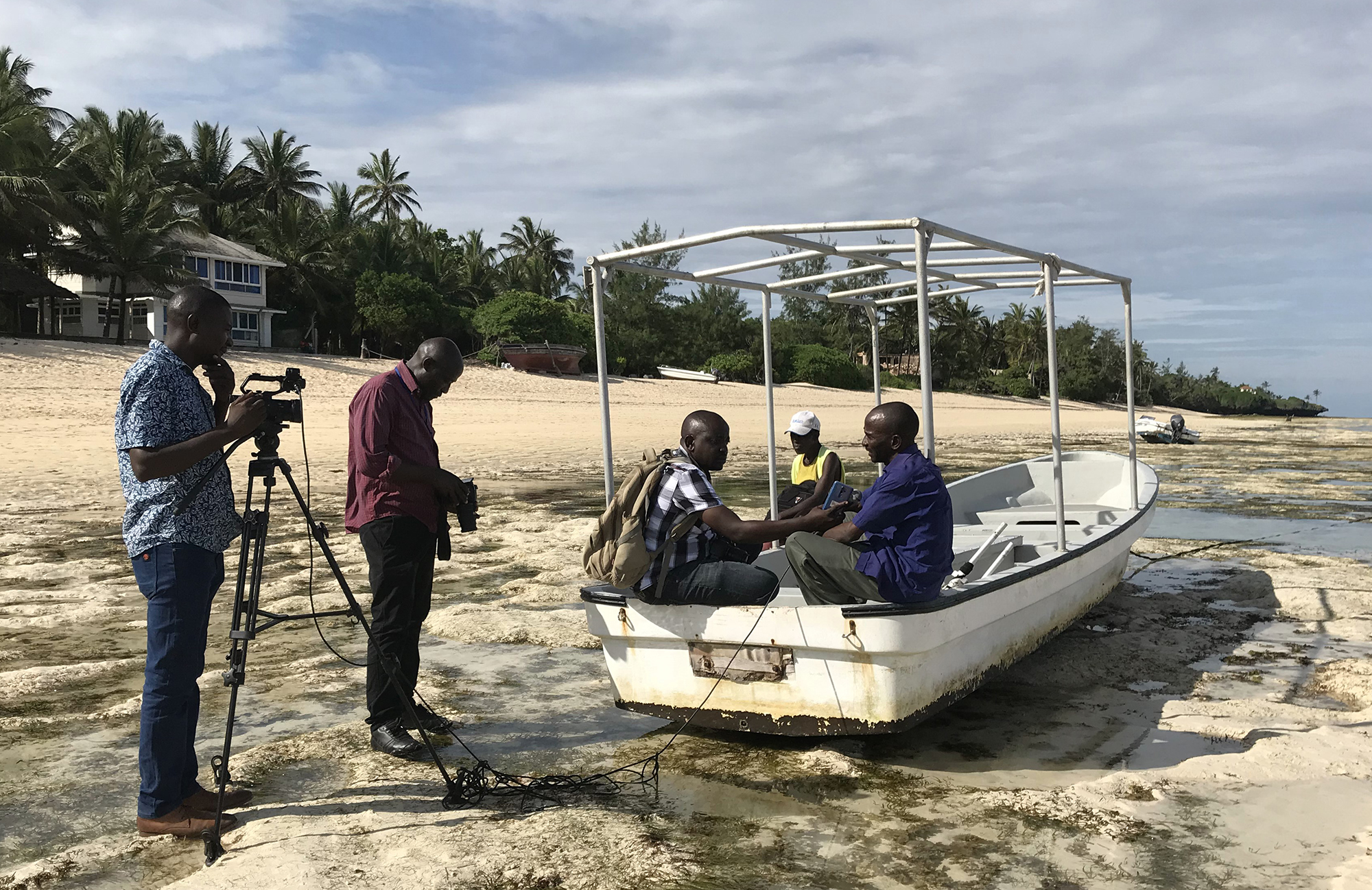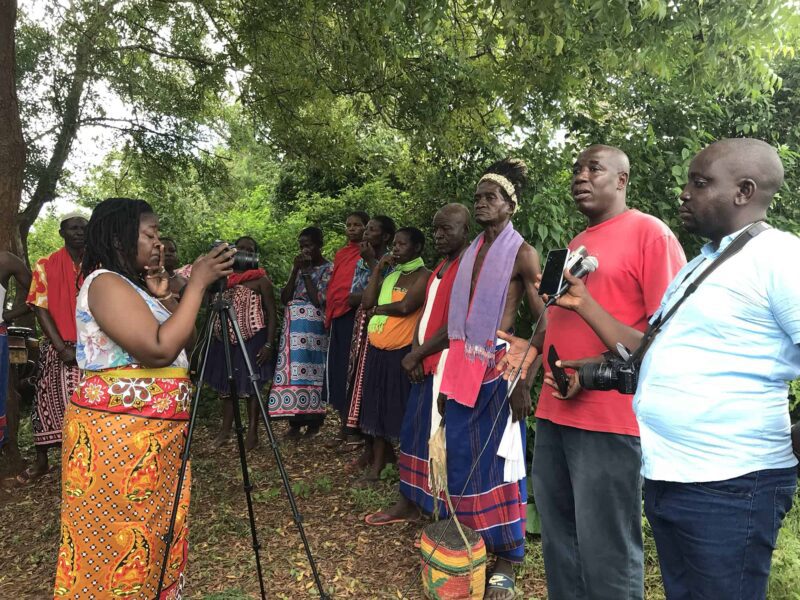BY Sara Schonhardt
Along Kenya’s coast lie several sacred forests, home to fortified villages occupied by elders who protect what are now some of the country’s only remaining coastal lowland groves. These elders belong to the Mijikenda people whose reverence for the forests as the abodes of their ancestors restricts the use of forest resources.
Now, the state is trying to adopt some of those values, and together with environmental groups like the WWF they’re helping support the kaya and the coastal forests from threats posed by deforestation.
Kasichana Tsuma, the 52-year-old treasurer for the council of elders in the Kaya Kauma forest near Kilifi, sums up the value of their protection work by saying, if people were allowed to cut trees for firewood or other uses, “the forest would expire.”
It was here in Kaya Kauma that Internews’ Earth Journalism Network wrapped up a week-long media workshop recently with 17 journalists from across East Africa.
Over the course of five days the journalists were introduced to wildlife and conservation issues – everything from poaching of endangered species such as rhinos, whose horns are believed in some Asian countries to carry medicinal value, to the value of preserving coastal reefs as sanctuaries for marine biodiversity.

They heard from experts like Arthur Tuda, Head of Ecosystems and Landscape Conservation and Management at the Kenya Wildlife Service (KWS), who opened the workshop by talking about the important role that media can play in raising awareness among the public about the need for conservation.
“If we spend a bit of time telling the people why preserving nature and keeping our environment clean will result in better health, than I think we could do a better service to our community,” he said, referring to a recent story about contaminated maize.
“Let’s try establishing those links between the benefits so people see the value of protected areas in their entirety,” Tuda continued.
The Earth Journalism Network’s East Africa Wildlife Journalism project aims to grow the amount of reporting on wildlife crime and conservation by helping reporters better understand the issues; tell compelling, solutions-focused stories; and build reliable, expert sources.
The workshop, held in Mombasa from 18-22 November, covered the illegal wildlife trade, including demand and supply drivers; law enforcement challenges; marine conservation; and the role of indigenous knowledge, among other more reporting-focused sessions. It also explored how to counter challenges reporters face due to a lack of time, money or expertise, resistance from newsrooms to cover environmental issues or threats from vested interests.
Journalists had several opportunities to see conservation efforts firsthand, starting with a demonstration by KWS’s canine unit, which is working to detect the smuggling of wildlife goods at the port in Mombasa.
KWS is also focused on stemming human-wildlife conflicts, a growing problem as habitats around national parks are being destroyed by development, driving wildlife into towns and villages.
The journalists also heard from Wildlife Direct, a non-profit conservation organization, as to how different communities and individuals are responding to problems of poaching using innovative approaches. In some places, for example, people have hung beehives around their villages to prevent crop raids by elephants following research that found elephants fear the insects.
Wildlife Direct works to uncover and share these stories by engaging with communities. It also supports a project called Eyes in the Courtroom, which collects, analyzes and monitors wildlife crimes in Kenya in an effort to see more prosecutions. Maurice Nyaligu from WWF Kenya talked about endangered species and their implications and how trafficking through the ports is helping fuel the wildlife trade.
On Day 3, the group visited Kuruwitu Conservation & Welfare Association, a community-managed marine conservation project started in 2003. To address concerns about uncontrolled fishing and impacts from climate change, such as coral bleaching, it now provides support to local fishing communities to protect the reef that lines the coast. Along with partners such as Kenya-based NGO Oceans Alive, it is working to teach other groups and communities up and down the Indian Ocean coast how to locally manage marine areas.
In addition to creating marine sanctuaries that are having spillover effects on surrounding fisheries, the group is working on coral regeneration and turtle habitat protection and bringing in money through boat and snorkeling tours.
“The whole way conservation is going to work, is if people see the benefit themselves,” said Des Bowden, Oceans Alive founder.
Several participants said the workshop helped them better understand the importance of biodiversity and conservation and the need to raise awareness about its value at a time when environmental news is focused narrowly on climate change.
Some said learning about the threat that human-wildlife conflicts pose to biodiversity helped them think about solutions-based reporting. Others noted it was important to follow the money and investigate the factors driving wildlife crime. For some, the biggest take away was understanding the role local authorities, law enforcement and even communities can play in conservation.
“It’s not just about authorities pushing stories to us, it’s about us explaining to the public the importance of wildlife, conservation and climate change,” said Jane Okoth, a media manager with Wildlife Works. “We need to rethink how we’re doing wildlife and conservation stories to make everyone be responsible, not just the authorities but the public at large.”
The biggest lesson participants voiced, however, was on the value of collaboration and of getting to know other reporters working on similar issues and learning from them.
“When I cover wildlife stories in Uganda it feels like I’m alone, so I’m happy to meet other people working on similar stories in other countries,” said Gerald Tenywa from New Vision.
Joseph Muchiri from the Standard Group in Kenya said, “I’ve become a better journalist than the way I have been – from Monday when we visited the marine park, to Kuruwitu, to yesterday at the Kaya Kauma, it has been a new experience.” Learning about the issues affecting the environment, wildlife and conservation taught him of their severity, he said, and those lessons “will allow us to come up with stories that will have an impact.”
Workshop participants have already produced a handful of feature stories from the workshop, including ones like this focused on community responses and with many more being drafted through continued mentoring.
The workshop was part of a broader EJN project on East Africa Wildlife and Conservation Journalism funded by the US Agency for International Development and the US Department of Interior.
(Banner photo: Workshop participants interview some of the council of elders of Kaya Kauma before going into the forest. Credit: Internews)
